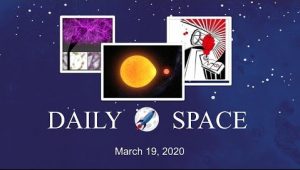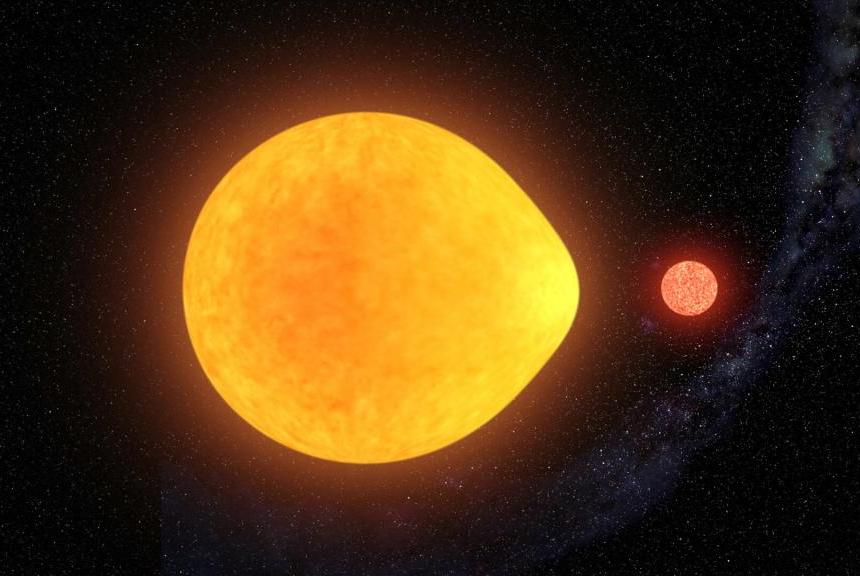
Astronomers use slime mold algorithms to map the known universe, a pulsating variable star is found that only pulsates on one side due to gravity from a binary companion red dwarf, and a binary system of two brown dwarf stars has been found by the SPECULOOS survey.
Links
Slime Mold can map Universe
- Astronomers Use Slime Mould to Map the Universe’s Largest Structures (Hubble Space Telescope)
- Astronomers use slime mold model to reveal dark threads of the cosmic web (UC Santa Cruz)
- Slime mold simulations used to map the dark matter holding the universe together (Hubble Space Telescope)
Variable Star pulsates on only one side
- New kind of star only pulsates on one side (UPI News)
Binary System of Two Brown Dwarfs found
- Astronomers Catch Rare Eclipse Of A Double Brown Dwarf System (Keck Observatory)
Transcript
This is the Daily Space for today, Thursday, March 19, 2020.
Welcome to the the Daily Space, I am your host, Dr Pamela Gay, and I am here to put science in your brain. Most Mondays through Fridays either I or my co-host Annie Wilson will be here, bringing you a quick run down of all that is new in space and astronomy.
Today’s news is full of stories that kept taking turns for the unexpected. Mistakes may be made in covering this first story, but it definitely is one you need to know about – so you can laugh!

They then analysed the light from 350 faraway quasars cataloged in the Hubble Spectroscopic Legacy Archive. These distant cosmic flashlights are the brilliant black-hole-powered cores of active galaxies, whose light shines across space and through the foreground cosmic web.
CREDIT: NASA, ESA, and J. Burchett and O. Elek (UC Santa Cruz)
Over the past decade or so, researchers have been realizing that slime molds are better at optimizing travel paths than anything else. Build a tiny city with slime mold food at building locations, and they will optimize delivery routes. Layout a nation of cities, they’ll optimize the highways. Slime molds… they work together to get that mapping done. No, I don’t know how single celled organisms do this, I just know they do. Computer science researchers have been trying to learn from the mold, and have created algorithms based on how the molds seem to decide their paths. These algorithms are able to produce the same kinds of dendritic looking paths that we’re used to seeing in, well, trees… And the large scale structure of the universe.
As our universe formed, it gravitationally collapsed from a mostly smooth cloud of material into clusters and walls of galaxies. Because this is all driven by gravity, you end up with these cool gravitational potentials that map to the shortest paths between the biggest clusters. Knowing that is awesome. Mapping that is hard.
This is where the slime mold comes in. Slime has our back on the mapping.
To be clear, much to my disappointment, scientists did not create a physical map of galaxies and let the slime mold connect the model galaxies. When I read the headline “Astronomers Use Slime Mould to Map the Universe’s Largest Structures” I had so much hope that actual slime mould would be involved… no – slime mold computer algorithms were involved – NOT actual slime mold. Using these algorithms and data from the Digital Sky Survey that provided positions of galaxies, the team had the slime mold algorithm map where the LSS should be, and then they used archival data from the Hubble Space Telescope to go looking to see if they could confirm the slime mold algorithms results.
And they could! In the light of 350 distant quasars they could trace out the hydrogen gas that stretches between the galaxies. The cool thing about using the algorithm instead of actual slime mold is the algorithms work in 3 dimensions, just like our universe. That said, I’m hoping that some bored research team recreates this work with actual mold. We have links to this research on our website, DailySpace.org. This research is published by J Burchett and company in the Astrophysical Journal Letters.

Alright, from this tale of the cross disciplinary awesome, we now jump to another story of things going sideways. In this case, we actually mean sideways.
A new star has been identified that is a pulsating variable star… but only half of it. In a binary system with a delta Scuti variable star and a regular red dwarf, the gravity of the tiny red dwarf is able to distort its 1.7 solar mass companion in such a way that the stars regular expansion and contraction only occurs on one side, and the regular brightening and dimming is only seen in some orientations of the binary system. This kind of star has long been theorized, but had never been seen until now. This system was spotted by the TESS spacecraft as it looked for transiting exoplanets, and showing that one scientist’s noise is another scientist’s data. According to Don Kurtz of University of Central Lancashire, “I’ve been looking for a star like this for nearly 40 years and now we have finally found one. Gerald Handler, of Nicolaus Copernicus Astronomical Center adds “The exquisite data from the TESS satellite meant that we could observe variations in brightness due to the gravitational distortion of the star as well as the pulsations.” As we perform more and more surveys we’re going to turn up more and more rare objects that help us see the full distribution of weird and awesome that our universe has combined objects to create.

An artist’s view of one of the SPECULOOS telescopes, with the eclipsing binary brown dwarf in the sky. The third red dot is a third nearby brown dwarf, which is also part of the same system. The book on the side shows the data that led to the discovery. On the left page is the eclipse captured by SPECULOOS while the right page shows the data from Keck Observatory and the VLT.
CREDIT: University of Birmingham/Amanda J. Smith.
In another case of surveys finding the hard to find, a new paper in Nature by Triaud and company identifies a binary system made of two brown dwarf stars in the SPECULOOS survey, which is designed to find potentially habitable planets. While this system isn’t likely to have life, it is nonetheless super cool. Literally… these stars have failed and are just barely glowing through the combination of heat from compressed gas and residual hit from brief burning of heavy hydrogen. This particular system is super interesting because the stars are precisely aligned to eclipse one another, which allows us to measure their size and mass accurately, giving us some of our best data on the nature of these tiny hard to find not-quite-stars. This system got follow up from the 8-m VLT. They found the system also has a 3 brown dwarf companion, making this brown dwarfs all the way down. Unfortunately, I hit a paywall when I tried to read about what size these stars were found to be… so I can’t tell you, but I can tell you, we now know. Stay tuned. We’re going to try and find someone with access to this paper, but for now, now we have found a small commune of failed stars hanging out in the not so distant universe.
<———————>
And that rounds out our show for today. As part of helping keep us all occupied in these really weird times, we’re going to be hosting a lot of additional content on our Twitch channel, and we want to remind you that CosmoQuest has an active community on Discord where you can talk science and even find other people to join you in playing some online games. You can find links to everything that is going on at CosmoQuest.org.
Thank you all for listening. Today’s script was written by Pamela Gay, and the Daily Space is produced by Susie Murph. The Daily Space is a product of the Planetary Science Institute, a 501(c)3 non profit dedicated to exploring our Solar System and beyond. We are here thanks to the generous contributions of people like you. The best way you can support us is through Patreon.com/cosmoquestx Like us? Please share us! You never know whose life you can change by adding a daily dose of science.


 We record most shows live, on Twitch. Follow us today to get alerts when we go live.
We record most shows live, on Twitch. Follow us today to get alerts when we go live.